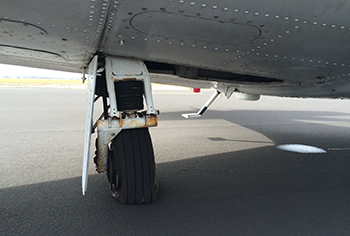Understanding Aircraft Tires
From air pressure to the durability of retreads, here’s what every owner should know about one of the most critical components of their aircraft.

[FLYING file photo]
Tires are a critical component of your aircraft. Knowing the exact specifications is vital to flying-approved and safe operation. Failure to maintain them could eventually create severe consequences.
Aircraft did not start off with tires, or even wheels, for that matter. The Wright Flyer did not use landing gear. Instead, the launching rail system consisted of four 15-foot two-by-fours totaling 60 feet.
"[In 1909] Goodyear developed the first pneumatic aircraft tire, which replaced the runners and bicycle tires on pioneer airplanes like the Wright Flyer," the company said.
It wasn’t until 1983 that Goodyear made the first radial tire approved by the FAA.
Specifications
The OEMs specify the specific tire size, ply rating, and pressure requirements for each individual aircraft. These elements directly impact the taxi parameters and landing operation.
During tire changes, it is crucial to install only approved aircraft tires.
Several tools assist in selecting the appropriate aircraft tire for your specific application.
Goodyear Aviation Tires features an online application guide where you can look up tires by size, part number, or aircraft.
The Goodyear Aviation Data Book contains seven sections to assist you in navigating the aircraft tire space. This booklet presents specific data on the proper tire sizes for different aircraft main and auxiliary/nose gears, speed ratings, nominal inflation pressures, dimensions, and other data users need to obtain the maximum service from their aircraft tires.
Automotive company Michelin also produces a line of aircraft tires. It also has a line of downloads to assist in outfitting your aircraft with the proper tire.
One way an aircraft component, such as a tire, gains approval is through a supplemental type certificate (STC) issued by the FAA. Michelin’s General Aviation STC, for example, may be found here.
All parts installed on certificated aircraft must carry some form of approval. Some approvals, such as parts manufacturer approval (PMA) parts, designated engineering representative (DER) repairs, and STCs, are alternate means of approval, which means the OEM does not support them.
Hazards
Aircraft tires are at a greater risk of damage due to their exposure to the elements, extreme temperature fluctuations, and high friction operation.
Common defects include:
- Wear: Uneven or excessive tread wear indicates that your tires may be improperly inflated.
- Sidewall damage: Cracking or bulging in the sidewalls can result from underinflation or harsh environmental conditions.
- Flat spots: Occurs due to heavy braking during landings.
- Foreign object damage (FOD): Debris on the runway can puncture or damage tires.
- Neglect: Failure to maintain aircraft invites Murphy to hang out on your flight line.
Be wary of extreme air pressure loss. Goodyear urges the following: "Any tire removed due to a pressure loss condition should be returned to an authorized repair facility or re-treader, along with a description of the removal reason."
Maintenance
Aircraft tires play a crucial role in aircraft operation.
"Inflation pressure is the most important thing for the tire's life," said Tim Wong, service leader at VSE Aviation. "Check tire pressure before the first flight every day."
Also important are ply ratings.
"Ply rating relates to how much load the tire can withstand,” Wong said. “The higher the ply rating, the heavier the load. Also, ply rating is a 'rating,' not necessarily the number of layers in a tire.”
Retreads can also be a good value, according to Wong.
"If you've flown commercially, 90 percent of commercial aircraft fly on retreads,” he said. “You will benefit from the OEM casing and longevity of our rubber. It's definitely a great value with no risk."
Tire pressure is the single most impactful maintenance item for aircraft tires, according to Philip Weber, former vice president of sales for Bridgestone Aircraft Tire.
The OEMs design aircraft tires to lose pressure as they fly, on average 2-3 percent per landing, to vent gasses that build up between the rubber layers. Regular tire pressure monitoring and maintenance will ensure proper performance and maximize safety.
Sidewall deflection is the biggest determining factor of aircraft tire longevity. The more sidewall deflection, the more quickly the tire wears, and the casing becomes scrap. Higher ply ratings give the tire more sidewall stability, resulting in more carrying additional weight. In addition, some tires have layers of Kevlar to improve tire puncture and FOD protection.
Retreads perform as well, and often better, than the original new tire. Unlike semitruck tires, where the new tread is simply welded to the outer surface of the casing, aircraft tires go through a complete re-baking process every time they are retreaded. This process makes the retread tire like new again.
Additionally, the baking process stiffens and seats the tire bead, which creates tires that are often easier to install and pressurize. In some cases (Boeing 737NG as an example), a retreaded tire can have a deeper tread than the original tire, providing longer on-wing life.

Sign-up for newsletters & special offers!
Get the latest FLYING stories & special offers delivered directly to your inbox






